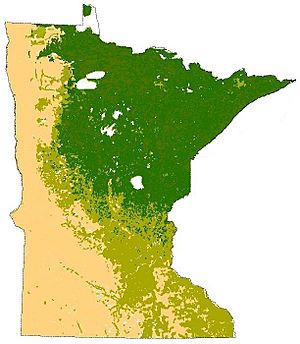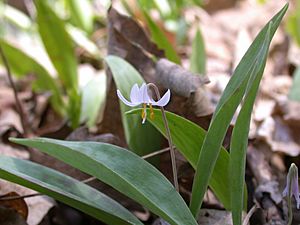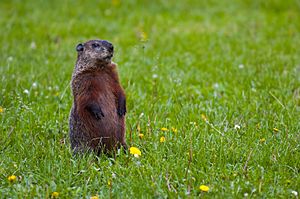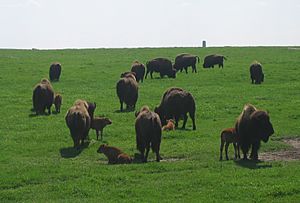Natural history of Minnesota facts for kids
The natural history of Minnesota is all about the amazing plants and animals found in the U.S. state of Minnesota. Minnesota has a continental climate, meaning it has hot summers and cold winters. Its special location, where the Laurentian Upland and the Interior Plains meet, shapes its plant and animal life. Three major natural areas, called biomes, come together in Minnesota:
- Prairie grasslands in the southwest and west.
- Eastern temperate deciduous forests (trees that lose their leaves) in the central and southeast.
- Temperate coniferous forests (trees with cones and needles) in the north-central and northeast.
Contents
What are Ecoregions in Minnesota?
An ecoregion is a special area defined by its unique environment and natural features. In Minnesota, ecoregions were greatly shaped by the state's ice age past, rock formations, soil types, how land is used, and its weather patterns.
Different groups like the United States Environmental Protection Agency and the Minnesota Department of Natural Resources have their own ways of classifying Minnesota's ecoregions. But they generally agree on the three main types:
- The coniferous forest in the north-central and Arrowhead areas.
- The temperate deciduous forest in the central and southeast.
- The tallgrass prairie in the southern and western parts of the state.
The northern coniferous forests are vast wild areas. They are filled with pine and spruce trees, mixed with patches of birch and poplar trees.
Amazing Plants of Minnesota
A lot of Minnesota's northern forests have been cut down over time. Today, only a few areas of very old forests remain. You can find some of these in places like the Chippewa National Forest and the Superior National Forest. The Boundary Waters Canoe Area Wilderness within the Superior National Forest has about 400,000 acres (1,600 km²) of land that has never been logged.
Even though logging still happens, new trees are always growing. This means about one-third of the state remains covered in forests.
Rare and Endangered Plants
Some plants in Minnesota are very rare and need protection. The U.S. Fish and Wildlife Service lists these plants as threatened or endangered:
- The Prairie bush-clover (Lespedeza leptostachya) is a threatened plant.
- The Western Prairie Fringed Orchid (Platanthera praeclara) is also threatened.
- Leedy's roseroot (Rhodiola integrifolia ssp. leedyi) is another threatened species.
- The Dwarf trout lily (Erythronium propullans) is listed as endangered, meaning it's in great danger of disappearing forever.
Animals of Minnesota and Their Habitats
Losing their natural homes has affected some native animals like the pine marten, elk, and bison. However, other animals like whitetail deer and bobcats are doing very well.
Minnesota has the largest population of timber wolves in the United States, outside of Alaska. The state also has healthy numbers of black bears and moose.
Birds and Fish of Minnesota
Minnesota is located on the Mississippi Flyway, which is a major path for birds that migrate. This means many migratory waterfowl (birds that live near water) pass through the state. You can see geese and ducks here. There are also many game birds like grouse, pheasants, and turkeys.
The state is also home to many birds of prey, which are birds that hunt other animals. These include the majestic bald eagle, the red-tailed hawk, and the beautiful snowy owl.
Minnesota's many lakes are full of popular sport fish. You can find walleye, smallmouth and largemouth bass, muskellunge, and northern pike. The streams in the southeast are home to different kinds of trout: brook, brown, and rainbow trout.





